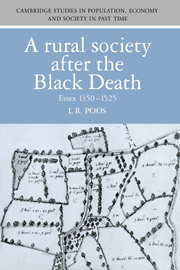Book contents
- Frontmatter
- Contents
- List of figures
- List of tables
- Preface
- Abbreviations
- Part I Reflections on a transitional era
- Part II ‘Country-dwellers, common folk and craftsmen’
- Part III ‘The total sum of all persons’
- Part IV ‘While it is so forward between us’
- Part V ‘She came that day seeking service’
- Part VI ‘Beware of such holy men’
- Part VII Synthesis
- Bibliography
- Index
- Cambridge Studies in Population, Economy and Society in Past Time 18
Part V - ‘She came that day seeking service’
Published online by Cambridge University Press: 14 September 2009
- Frontmatter
- Contents
- List of figures
- List of tables
- Preface
- Abbreviations
- Part I Reflections on a transitional era
- Part II ‘Country-dwellers, common folk and craftsmen’
- Part III ‘The total sum of all persons’
- Part IV ‘While it is so forward between us’
- Part V ‘She came that day seeking service’
- Part VI ‘Beware of such holy men’
- Part VII Synthesis
- Bibliography
- Index
- Cambridge Studies in Population, Economy and Society in Past Time 18
Summary
Since such a high proportion of the district's residents worked for wages, the local labour market's structures were significant features of the rural economy, but they also bore major implications for demography and social structure. It was a labour market that had not developed into full proletarianisation: money wages were merely one component of most workers' overall standard of living. Available sources for reconstructing structures of hiring are mostly oblique and partial. For example, the Statute of Labourers (1351) and its subsequent reenactments and enlargements, notably the Statute of Cambridge (1388), attempted to restrain wage-rate increases and regulate terms of employment, but recorded indictments under its terms present only one particular, problematic perspective upon hiring.
The district's labour force comprised both servants and labourers. Servants were largely young, unmarried, and resident in employers' households, and they received a major portion of their remuneration in the form of bed and board. They were highly mobile, often changing employers annually. For many in the district, servanthood was what came after early adolescence and before marriage.
Labourers, on the other hand, largely occupied their own households, though less likely to be married than contemporary agriculturalists. They too were mobile, likely to change residence further through the course of their lives than other occupational groups, and especially moving about on a short-term basis during harvest season. Their pay was much more exclusively in money, but their work patterns were highly seasonal and discontinuous.
- Type
- Chapter
- Information
- A Rural Society after the Black DeathEssex 1350–1525, pp. 181 - 182Publisher: Cambridge University PressPrint publication year: 1991
- 1
- Cited by



